#Campbell’s Soup Box: Chicken Noodle with White Chicken Meat
Text
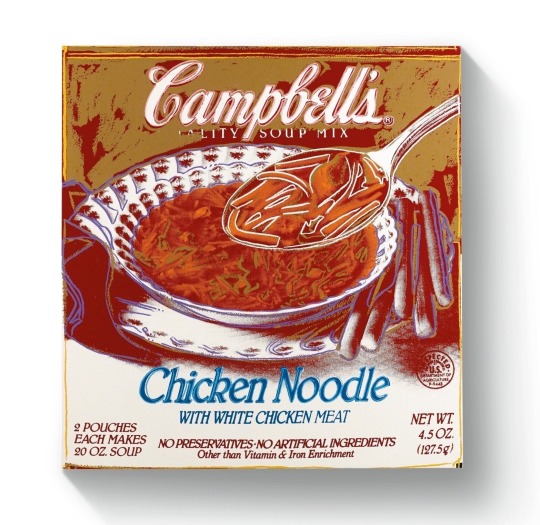
Campbell’s Soup Box: Chicken Noodle with White Chicken Meat
Andy Warhol
acrylic and silkscreen ink on canvas construction, 1986
#Andy Warhol#art#artist#pop#painter#Campbell’s Soup Box: Chicken Noodle with White Chicken Meat#mixed media#acrylic and silkscreen ink on canvas construction#1986
17 notes
·
View notes
Text
Homecookings [May ed.]
Cheers to the end of another month~
I had my 2nd staycation of the year in mid-May, & it was productive! I got a lot done, for real! I did some watercolour practice~ Below are some works I did during this month; I used my Korea photos as a guide. It was fun!



I also watched some Kdramas; I highly recommend Rugal! If you’re into Kdramas like The K2 or City Hunter, you’ll like Rugal. There’s action, a little bit of sci-fi, crime (gang/organizations vs NIS teams), & excellent cinematography. Born Again is another Kdrama I watched; it’s not done airing yet so I guess I’m still technically ‘watching’ it. Despite low ratings, I am enjoying it! I like the 3 leads A LOT!
As you all know if you’re in Alberta (/Canada), things started to reopen. I’m not sure if it is a wise decision, but I will still keep on practicing social distancing. I mean, that only means I’m going to/from work anyway - again, this whole thing hasn’t impacted me all that much. In fact, when my BFFs & I had another video chat session to catch up/celebrate a birthday, a question discussed was “how has quality of life changed during the pandemic / how it’ll affect short term and/or long term QOL once it’s all over?” Tbh, my QOL has improved! Not significantly, but there has been some positive changes. I actually feel happier to be seeing less ppl (friends included). This reclusive life while keeping in contact via “wifi” has been the best of both worlds for me. I do miss going to Hmart... lol but other than that, I’m pretty self-sufficient at home. I’ve got loads of coffee, adequate amount of snacks, plenty of books to read, not running low of art supplies anytime soon. .. I’ve literally got everything that I need, you know what I mean? I even have things that are on my to-do/to-try lists that I can start if I want to *shrugs* I consider myself one of the lucky ones that aren’t affected, & I’m super grateful for it.
PS: I do need to watch out for the “Quarantine 15″ HAHA but I don’t think that will be an issue for me. Actually, who knows.. . continue reading this post & let me know if you think I’ll gain the Quarantine 15 :P

^ This is my cocktail consisting of cold milk, hot chocolate powder, instant coffee powder, & the cappuccino honey. It’s basically a cold mocha (not iced! Bcos I had no ice in it!). It was refreshing~ Some days in May were hot!

^ My homemade kimchi wrapping (cut up) pork loin. The kimchi I made (the 1st jar that I opened was kinda sour so it paired well with meats or to be eaten on its own; not the most ideal for soups). This was very refreshing! I only lightly seasoned the pork with salt & fresh ground black pepper. Then I peeled longitudinal strands of my napa cabbage kimchi & wrapped small pieces of the pork loin. Excellent appetizer, if I do say so myself :D

^ Hearty soup! I’m slightly surprised I haven’t shared this on here yet (at least I don’t think so). You know the Campbell brand creamy Thai chicken & rice soup? I LOVE LOVE LOVE that soup so much. I’d say it’s in my top 3 of the ones I’ve ever tried. Anyway, on its own, it is too salty for me. So what I do is dilute it with more veggies + water. Using about 1/3 of the can each time, I add anywhere between 1-2 cup of water with it into a pot, then add in whatever veggies I have: green cabbage, napa cabbage, mixed frozen corn/peas, tomato, cauliflower, & broccoli. These are my main choices. The amount I add depends on what else I have for the meal. The natural sweetness from the veggies give it a very good flavour, but the “background” Thai taste is still present.
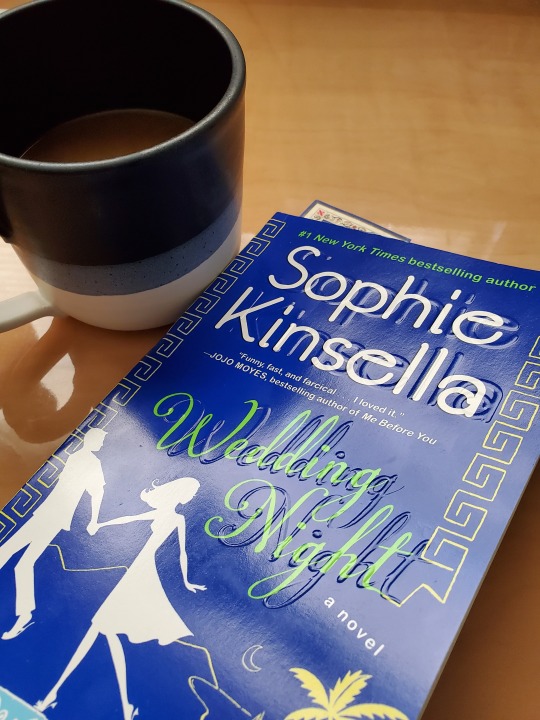
^ My fancy hot chocolate with a book.. . This is my 3rd Sophie Kinsella book. I didn’t think I would be into her books but surprisingly I am.. . Her female protagonists are all kinda similar lol at least for the ones I’ve read anyway. But umm the fancy hot chocolate! It is a gourmet hot chocolate mix I purchased from the Butterdome Craft Fair back in December. I put it away & then the holidays passed.. . anyway, this was the Noel-blend, so it has a very chai feel to it with nutmeg & cinnamon. I tried a little bit of it before, & got no allergic reaction from it, so I up’ed my amount this time.

^ Random May afternoon snack while on staycation.
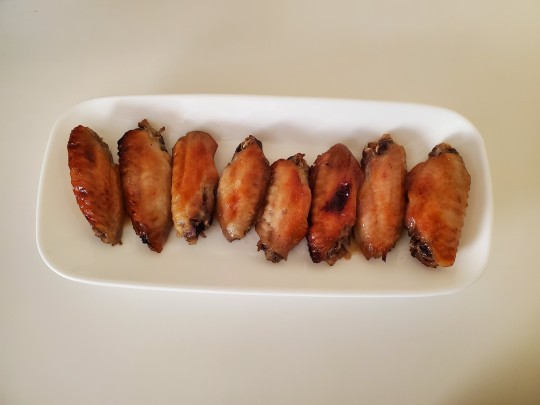
^ 2-ingredient baked wings. There are a lot of Asian-inspired sauces for marinating/cooking meats, I find. Like you always hear soy garlic, honey garlic, or ginger sesame, teriyaki, etc.. . you know what I mean? 1st of all, as a Chinese person, do I particular cook with these combos of condiments/sauces? No... lol I think it’s a very Westernized concept... OR the other good one is, “drizzle sesame oil on everything!” Which I also don’t do... Recently, there has been a lot of wings happening in my household, so I’m trying diff things with them. For these baked wings, I marinated the wings in (diluted) hoisin sauce + fish sauce. Hoisin sauce is sweet, while fish sauce is super salty. I think I added about the same amount of each...then added some water. Marinated these 8 wings for 5-6 hrs, then baked them for ~40mins. I didn’t turn them around, so only the skin side is dry-ish, while the bottom is moist + juicy.
PS: I prefer this 2-bone wing piece (rather than the drumlette, aka the mini drumstick that’s attached to this wing piece). How about you?

^ Upgraded rice cake + dumpling soup. I added cheese, furikake flakes, as well as 3 kim-mari’s (deep-fried seaweed rolls).
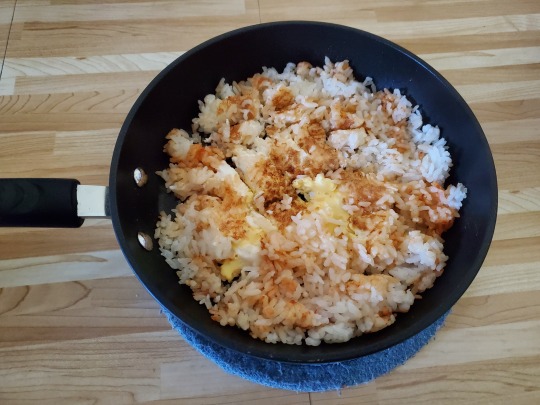
^ Simple fried rice (just egg + leftover rice, with a tsp of soy sauce)

^ Grilled meat (pork + beef), kimchi, rice, & radish + pollock soup. 1st time using the electric contact grill in 2020! It has been around for so long, but we just don’t use it; so it made its way down to our basement storage...... It now resides in the kitchen but unsure how long it will stay........ Mom thinks it’s in the way, esp for such an infrequently used appliance. Tell me, what else should I use it for so it can stay around for longer?! :P
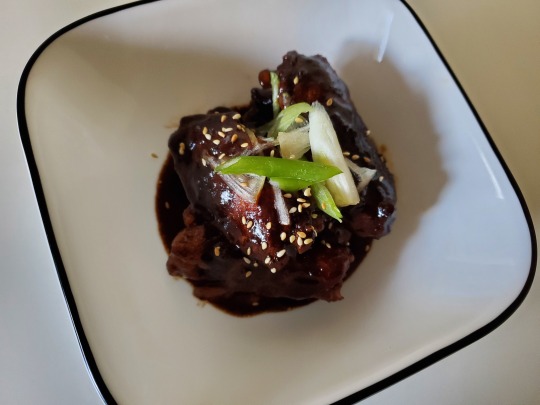
^ Jjapa-guri wings! THIS WAS SO AMAZING! Okay, have you guys watched Parasite? If not, that’s ok, just familiarize yourself with “jjapa-guri”. Long story short, it is a combo of 2 instant noodle (flavours): blackbean sauce + the Neoguri powder. The name is a compound term of the 2 essential components. For these wings, I used my blackbean sauce (from jar), with the Nongshim (instant noodle) kimchi powder. Can’t see the redness bcos the blackbean sauce is so dark. But anyway, I pan-fried the wings, & then they’re about 50% cooked, I added spoonful of the blackbean sauce & added some kimchi powder in (also some water so there’s a bit of a sauce created). So tasty!!!

^ Basa fillet stir-fry with rice. The stir-fry contains: choy sum stalks, green cabbage, bell peppers, & thin rice cakes. For the sauce, I used abalone sauce + sugar. Abalone sauce is more salty & has a more deeper flavour than oyster sauce, so a little bit goes a long way (at least the brand we have anyway). For my singular serving amount of ingredients like this for a stir-fry, I normally add 1 almost-overflowing tsp of oyster sauce. I added the same amount of abalone sauce & it was too salty for me personally. So I added sugar (not sure how much I added.. . maybe 2 tsps?). I don’t think abalone sauce is very common to the Western population, but it’s an item easily purchase-able at Asian grocery stores! Next time you’re in one, you should buy a small bottle & try it out!

^ “Hotpot leftover special”. Threw some leftover things from hotpot & made it into a soup. Over a bed of instant noodles :P Bcos it is my staycation, so I’m eating 2 instant noodles within 1 week *gasp*
PS: I normally like the plain white surface for my photos. What do you think about this colourful tablecloth? Personally speaking, too colourful, vibrant, summer-y & bright for my liking.

^ Nestle drumstick (the fudge flavour). 1st one in 2020~ Does anyone know how long these can be stored for in the freezer? No expiry or best before date on the box; this was a Costco product & there are 18 drumsticks (9 fudge; 9 caramel). 1 box of 18 probably lasts us like... 7 months HAHA bcos we eat it so infrequently. It’s crazy, I know. Looks amazing in the photo, but the cone part is like getting kinda soft. Esp at the bottom, it’s kind of.. . chewy. Still tastes fine & everything; but the cone is softened.
This is it for now. Hope you’re staying healthy & safe, wherever you are.
1 note
·
View note
Link
Bulgur biscuits and a granulated synthetic protein dubbed 'multi-purpose food' promised long shelf life—but not much else.
What were postwar Americans planning to eat in the event of a nuclear attack? Hint: It wasn’t very appetizing.
With Cold War tensions escalating in the 1950s, the threat of a Soviet nuclear attack cast a terrifying shadow over everyday American life. In schools, children learned to “duck and cover,” diving under their desks and staying far away from windows in drills designed to protect them during an atomic strike. Families across the country (at least those who could afford it) built fallout shelters in their basements and backyards. Community shelters were constructed beneath municipal buildings, and emergency government bunkers were carved into hillsides.
As ridiculous as it seems now, given what we know of the power of nuclear weaponry, these and other U.S. civil defense policies in the ‘50s and early ‘60s were based on the significantly flawed notion that most of the nation’s population would survive a catastrophic nuclear attack.
And when they did, they would need something to eat.
READ MORE: How 'Duck-and-Cover' Drills Channeled America's Cold War Anxiety
Grandma’s pantry
A woman as she takes an inventory of supplies for her household's fallout shelter.
In 1955, during the Dwight D. Eisenhower administration, the Federal Civil Defense Administration (FCDA) urged every family to keep a seven-day supply of food and water on hand in case of an atomic emergency. To encourage people to build this stash of provisions, the FCDA launched an initiative called “Grandma’s Pantry,” based around slogans like “Grandma was always ready for an emergency.”
The government produced 1,000 Grandma’s Pantry exhibits to use in stores and at fairs. According to a 2017 story in Eater in 2017, the department store giant Sears, Roebuck and Co. exhibited 500 of them in its stores, alongside shelves lined with fallout shelter-friendly consumer foods like Hawaiian Punch, Campbell’s Soup, Tang drink mix, candy bars and Kellogg’s Corn Flakes.
READ MORE: Nuclear Shelters Were Never Going to Work
The doomsday diet: survival crackers
A tin of biscuits found open, along with other survival supplies, in a fallout shelter dating from 1962, pictured in 2017.
During the crisis over Berlin in mid-1961, President John F. Kennedy expanded the nation’s civil defense programs, calling for more than $200 million in appropriations for the construction of public fallout shelters in the United States. Kennedy also encouraged Americans to build private shelters, the estimated number of which rose from 60,000 in June 1961 to some 200,000 in 1965.
By the early 60s, the U.S. Department of Agriculture had already developed what it considered the ideal “Doomsday food”: nutritious, easy to prepare and reasonably priced, with a long shelf life. The result of its efforts? A bulgur wheat biscuit dubbed the “All-Purpose Survival Cracker.”
Bulgur, a Mediterranean staple made from parboiled whole grains known as groats, has been consumed for thousands of years by everyone from Chinese emperors to ancient Babylonians. As Paul Visher, then the U.S. deputy assistant secretary of defense for civil defense, argued before Congress in 1962, bulgur’s “shelf life has been established by being edible after 3,000 years in an Egyptian pyramid.”
Though the bulgur biscuits were originally produced in a single plant in Seattle, the Pentagon soon enlisted the help of the nation’s biggest cereal and biscuit companies, including Sunshine Biscuits, Kroger, the Southern Biscuit Company, Nabisco and Keebler (then the United Biscuit Company of America). In all, these companies churned out more than 20 billion survival crackers by the end of the program in 1964.
READ MORE: Inside the Government's Top-Secret Doomsday Hideouts
‘Multi-purpose food’
View of food, sanitation and survival supplies issued by the U.S. Defense Department for stocking a 50-person public bomb fallout shelter during the Cold War, 1962.
General Mills also developed its own fallout shelter offering—though it bore little resemblance to actual food. The granulated synthetic protein known as Multi-Purpose Food came in a large white can and was included in the Emergency Pak Food and Water kits that consumers like Dr. Robert Parman, of Topeka, Kansas, purchased in the early 1960s.
According to the Kansas Historical Society, the three kits Parman bought to stock his family’s fallout shelter in 1961 (he later donated one to the Kansas Museum of History) were manufactured by a company called Surviv-All, Inc., of New York City. Along with the sand-like Multi-Purpose Food, they contained 24 pint-size cans of water, which was supposedly enough sustenance to keep survivors alive for two weeks—the amount of time civil defense authorities estimated it would take before radiation levels dropped low enough for people to emerge from their shelters and forage for food.
READ MORE: 5 Cold War Close Calls
Canned meat, drink mix and ‘Doomsday cookies’
Interior view of a family's fallout shelter from the 1960s. Among the supplies are a 14-day supply of water and canned food, a battery-operated radio, auxiliary light sources and first aid supplies.
While bulgur biscuits and synthetic protein grains may have been the government’s idea of the perfect fallout shelter food, many ordinary Americans turned to more conventional options when it came to stocking their emergency pantries. Canned vegetables and beans and preserved meats (think Spam and hot dogs) were popular choices, along with peanut butter, boxed cereals, canned juices, drink mixes and packaged crackers and cookies.
In her book Born Under an Assumed Name: The Memoir of a Cold War Spy’s Daughter, Sara Mansfield Taber wrote that she and her classmates “brought in cans of tuna fish, chicken noodle soup, jars of Tang (the drink of the astronauts), and Vienna sausages for the emergency stockpile” before hunkering down in the basement of a classmate’s home as part of a school air-raid drill. Tang also showed up in a 1960s shelter unearthed in the backyard of a Wisconsin home in 2013, alongside individual packs of cornflakes and cans of pineapple juice.
Though published in 2012, the popular Chicken Soup for the Soul Cookbook featured a Cold War-era recipe for “Doomsday Cookies.” The recipe’s author, Barbara Curtis, recalled doing duck-and-cover drills at school in the 1950s. At home, Curtis’s mother made her signature oatmeal, walnut and chocolate chip cookies in massive quantities to stockpile along with the “cases of Spam, Vienna sausages and oil-packed tuna” stored in the family’s garage.
The long afterlife of fallout shelter foods
Supplies line the walls of an intact fallout shelter dating from 1962, pictured 2017.
Though fears of a Soviet atomic attack had largely receded by the 1970s, replaced by concerns over the war in Vietnam and the Watergate scandal, some fallout shelter foods proved to have an even longer shelf life than their government boosters might have predicted—sort of. In 2006, workers in New York City were conducting a routine structural inspection of the Brooklyn Bridge when they came across a blast from the Cold War past: a stockpile of medical supplies, water drums and an estimated 140 boxes containing more than 350,000 “Civil Defense All-Purpose Survival Crackers.”
“It tasted like cardboard, but with a nasty backbite that stayed in your mouth for hours,” reported Iris Weinshall, the city’s transportation commissioner at the time. "I cannot think of eating a saltine now without that taste coming up."
from Stories - HISTORY https://ift.tt/2TkUWI3
February 27, 2020 at 12:34AM
0 notes
Text
Does Chicken Soup REALLY Heal Colds? (And If So, What’s The Best Recipe?)
Image source: Pixabay.com
When my kids don’t feel well, one of the only things they will eat is chicken soup – my homemade chicken soup.
But do they want the soup because it represents a strong comfort food they have known all of their lives, or is there something more?
The answer is yes, and the old wives’ tale is right. Chicken soup really is good for you.
Dr. Stephen Rennard and his team of researchers at the University of Nebraska Medical Center in Omaha conducted a series of tests to study the health benefits of chicken soup.
“Everyone’s heard this from their mother and grandmother in many cultures,” Rennard said. “We found chicken soup might have some anti-inflammatory value.”
After examining blood samples from study volunteers, the researchers found that homemade chicken soup reduced the movement of a type of white blood cells, called neutrophils, which help defend against infection. By inhibiting movement of these cells in the body, chicken soup can help reduce upper respiratory cold symptoms, Rennard theorized.
“Researchers suspect the reduction in movement of neutrophils may reduce activity in the upper respiratory tract that can cause symptoms associated with a cold,” the University of Nebraska said in a press release.
Fast, All-Natural Pain Relief With No Nasty Side Effects!
The study used a soup made by Rennard’s wife, Barbara. (The recipe is below.) But is also compared results of the homemade soup with several commercial brands of chicken soup and found similar results. The brands tested included Progresso chicken noodle, Knorr chicken noodle, Campbell’s Home Cookin’ chicken vegetable, Lipton Cup-a-Soup chicken noodle and Campbell’s Healthy Request chicken noodle.
Although they were not able to pinpoint exactly what ingredients made the soup so effective against cold symptoms, the research suggested that it is the combination of chicken and vegetables that does the trick.
An earlier study conducted by researchers at Mount Sinai in Miami found that consuming chicken soup helped sick study volunteers to breath better and to have less mucus. The 1978 report, which, like the 2000 Rennard study was published in the medical journal Chest, found that chicken soup boosts the function of cilia — the microscopic hair-like projections that help prevent germs from entering the body.
Given the nickname “Jewish penicillin,” chicken soup has been a mainstay for generations of mothers and grandmothers from many cultures who seek to comfort their families.
Some scientists theorize that chicken soup has anti-inflammatory properties and that the soup provides the fluids needed to flush out viral infections in the upper respiratory tract.
Staying well-hydrated is a key part of recovering from a cold or the flu. Research suggests then chicken soup may provide better hydration than either water or commercial electrolyte drinks. Here are other reasons chicken soup heals:
Chicken soup usually contains salt, which in a broth can help soothe your throat much in the same way that gargling with warm salt water can.
The soup’s warm liquid can help clear the sinuses with its steam.
Chicken provides lean protein to give your body strength when you are sick.
The vegetables in chicken soup can help heal the body. Carrots contain beta-carotene and celery contains vitamin C, both of which help boost the body’s immune system and help fight infection. Onions help reduce inflammation and can act as an anti-histamine.
Convinced? Here is the recipe for the soup used in the study:
Ingredients
1 5- to 6-pound stewing hen or baking chicken
1 package of chicken wings
3 large onions
1 large sweet potato
3 parsnips
2 turnips
11 to 12 large carrots
5 to 6 celery stems
1 bunch of parsley
Salt and pepper to taste
Directions
Clean the chicken, put it in a large pot and cover it with cold water. Bring the water to boil.
Add the chicken wings, onions, sweet potato, parsnips, turnips and carrots. Boil about 1 and a half hours. Remove fat from the surface as it accumulates.
Add the parsley and celery. Cook the mixture about 45 min. longer.
Remove the chicken. The chicken is not used further for the soup. (The meat makes excellent chicken parmesan.)
Put the vegetables in a food processor until they are chopped fine or pass through a strainer. Both were performed in the present study.
Add salt and pepper to taste.
(Note: This soup freezes well.)
Matzo balls were prepared according to the recipe on the back of the box of matzo meal (Manischewitz).
What is your favorite chicken soup recipe? Do you eat chicken soup when you are sick? Share your thoughts in the section below:
Every Year, Gardeners Make This Stupid Mistake — But You Don’t Have To. Read More Here.
This article first appeared on offthegridnews.com See it here
The post Does Chicken Soup REALLY Heal Colds? (And If So, What’s The Best Recipe?) appeared first on Homesteading Alliance.
0 notes